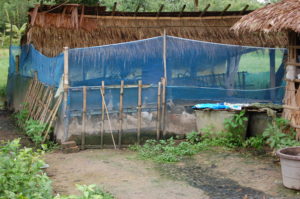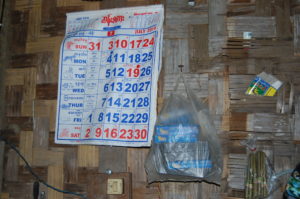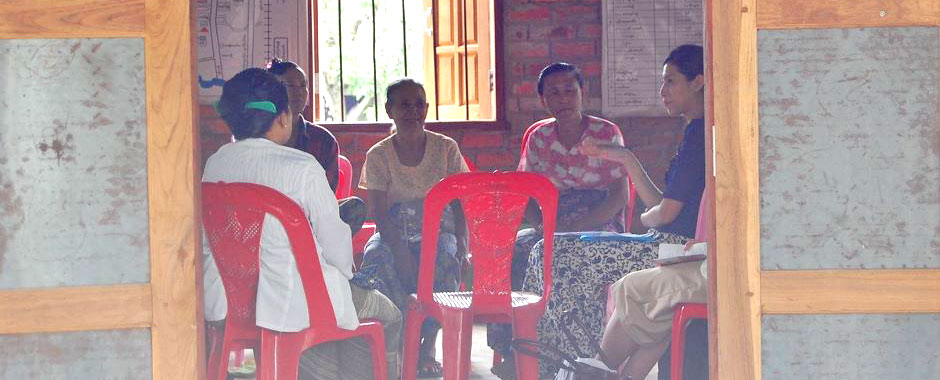I’m writing from a village 70km north of Yangon in Myanmar. A group of women farmers are talking about their experiences raising pigs. They have small herds, five to 30 head. Probably for all of them, this is their first experience of a focus group discussion and they are eager to have their say.
The project I’m working with, the Myanmar Pig Partnership, funded by the Zoonoses and Emerging Livestock Systems (ZELS) initiative, is trying to understand how pig-based livestock farming is intensifying in Myanmar, what the implications are for human and animal health and what practically can be done that would both improve farmers’ livelihoods and reduce health risks, reaching down the value chain.
Intensification of livestock farming
Disease is the women’s main worry in this monsoon season. Some have lost piglets and some their sows, the heart of the herd. They’ve seen more diseases in recent years and many of the symptoms are unfamiliar. Mostly they guess at how to treat them. They share their experiences with each other, what they’ve tried and what the result. And they describe the symptoms to the local input supply dealer or pharmacy. The shopkeeper guesses too but always suggests some product, usually an antibiotic or vitamin.
Many of the women have started using commercial feed for at least part of their pigs’ lives. The feed is laced with antibiotics to promote growth and pre-emptively treat bacterial disease. But the feed, like the medicine, is either not labelled or labelled in a language almost no one reads. Even if they could read the labels the women have little to draw on to help make sense of them.
The government livestock extension service is entrusted with providing farmers with reliable and neutral advice. Many of its officers are desperate to do better but the service, emerging from half a century of military rule and international sanctions, is overstretched, poorly paid and under-trained.
Agro-input industry

There are only a handful of really large pig farms in Myanmar. Most farmers still raise local breeds, relying mainly on local sources for feed. But these practices are changing. Myanmar’s neighbours – especially China, Thailand and Vietnam – have gone much further in these terms and have seen large increases in pork consumption, especially in urban centres. The agro-input industry sees a huge market opening, comparing Myanmar to China in the early 1980s and Vietnam in the late 1990s.
A question one doesn’t often hear asked is what Myanmar can learn from its neighbours’ experiences of intensification. And I have never heard anyone ask what can be learned from these countries’ experiences in the Green Revolution which transformed rice cultivation across Asia beginning almost 50 years ago.
As in the Livestock Revolution, farmers caught up in the Green Revolution confronted new diseases in the wake of technological change. The viral diseases and insect pests which often transmitted them caused large crop losses in sporadic epidemics. None of these diseases was a direct threat to farmers and their families, though the losses sometimes impoverished them.
Bacterial zoonoses
Zoonotic diseases, which pass between livestock and people, are some of what those women pig farmers have to deal with although many can’t distinguish them. Viral diseases like SARS and swine and avian influenzas, which have the potential to cross borders and regions, have attracted most attention, though they break out only rarely. More common are zoonotic bacterial diseases and parasites. In either case, it is those in direct contact with livestock who are at greatest risk.

Weapons targeting the disease-causing organism or pest have been the primary response promoted in both the Green and the Livestock Revolutions. Farmers have been encouraged to use pesticides on their crops and antibiotics on their livestock pre-emptively or on a calendar basis, regardless of what disease or pest or how much is present.
The pesticides rice farmers applied killed pests – but they also killed their natural enemies and the aquatic organisms rural people relied on. They also poisoned those who used them. One study in an intensive rice growing area in the Philippines concluded that pesticides were behind a 27% increase in adult male mortality.
Antibiotic resistance
The antibiotics that farmers, like those women, are using are not toxic to them. Their most important unintended consequence is likely the resistance they evoke in pathogens, including zoonotic ones, which may then be transmitted to other diseases of public health importance.
The contours of a more rational approach are similar in the two cases: emphasise prevention, highlight nutrition and care of the crop or livestock, and relegate pesticides or antibiotics to a measure of last resort. Bringing all this together and making a living requires farmers’ informed management.
And there’s the rub. Both revolutions rely primarily on small farmers to produce more food to meet growing, mostly urban, demand, encouraging them to employ complex technologies that are inherently hazardous – in the first instance to themselves – but invest very little in educating farmers so that they can make better decisions.
Education and regulation
Education programmes must be reinforced by effective regulation that controls what is marketed to farmers. Experience from the Green Revolution shows that these policies require sustained international support and civil society backing because there are strong interests pushing in the opposite direction. Elements of the agro-input industry have long opposed restrictions on pesticides and undermined farmer education initiatives.
A study in the Philippines found that the coalition around those policies was fragile largely because the consequences of pesticide abuse were felt mostly in rural areas with limited political influence. Rational antibiotic policies, which have still to emerge in most of the region, might have a broader constituency because the consequences of abuse can spread beyond rural areas and across borders.
That is still to be seen. The strength of the opposition must not be underestimated. Pesticides classified by the World Health Organization as Extremely or Highly Hazardous, which cannot be safely used under conditions of small farmer agriculture, are still widely marketed across Asia. Some well-known companies involved in this trade also market unlabelled animal feed containing unknown kinds and quantities of antibiotics. Large profits and with them much influence can be gained selling inputs to an expanding market.
Main image: Women discuss their pig farming practices in a focus group. Credit: Myanmar Pig Partnership

struggle is the best friend of farmer.